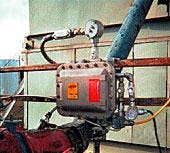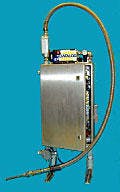Prototype gas detection probe for drilling mud developed for gas component analysis
The GasWizard total gas detection device in the photo on the left is shown on a Canadian land rig. Technicians can install the gas permeable membrane probe in the mud return line, close to the bell nipple or wellbore (Fig. 1).
Datalog Technology Inc., Calgary, reported in a June press release that it is testing a new version of the GasWizard gas detection device, jointly with Shell Oil Co., Houston.
Rig personnel can determine constit- uent components of any detected gas, with the new version of the device, which has gas chromatographic capabilities. The instrument determines mole fraction methane (C1) through octane (C8).
The new version of the device uses the same gas permeable membrane technology as the existing commercial version, which is capable of percent by volume total gas measurement only.
The gas chromatographic version of the GasWizard device in the photo on the right determines mole fraction methane through octane (Fig. 2). Photos courtesy of Datalog Technology Inc.
Operators will be able to identify formation fluids with much greater accuracy and speed, with quantitative formation fluids analysis immediately after gas zone penetration.
Mud loggers normally use gas traps at the possum belly or header box to strip gas out of the mud stream, for detection and analysis. The advantage of the new technology is obtaining quantitative gas data without the problems of traditional gas trap sampling.
The small gas permeable membrane sensor is installed on or close to the bell nipple allowing early gas detection, before gas losses occur in the flowline. The gas detection response time of the probe is faster than traditional gas traps, improving early kick detection and rig safety.
Shell and another operating company use the commercial version of the device in Gulf of Mexico drilling operations. The device is also widely used onshore in Canada and South America, and it has recently been certified for use in the North Sea.



